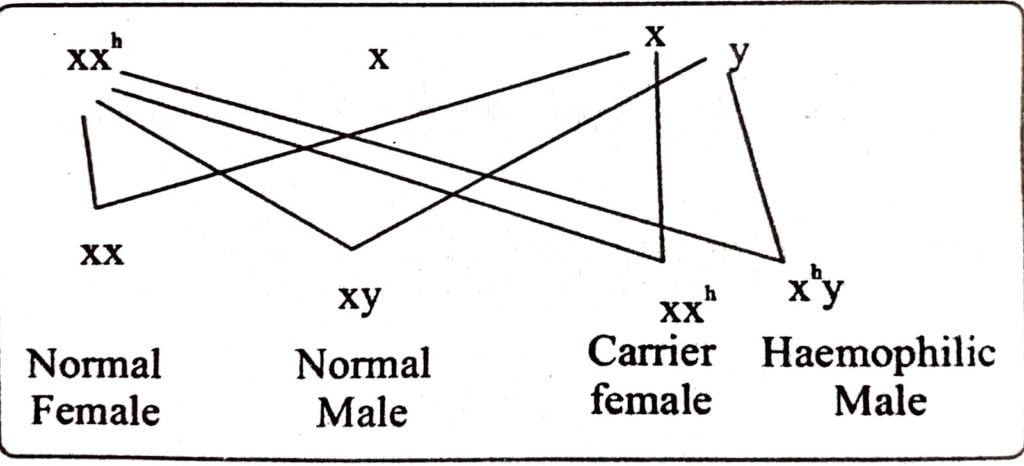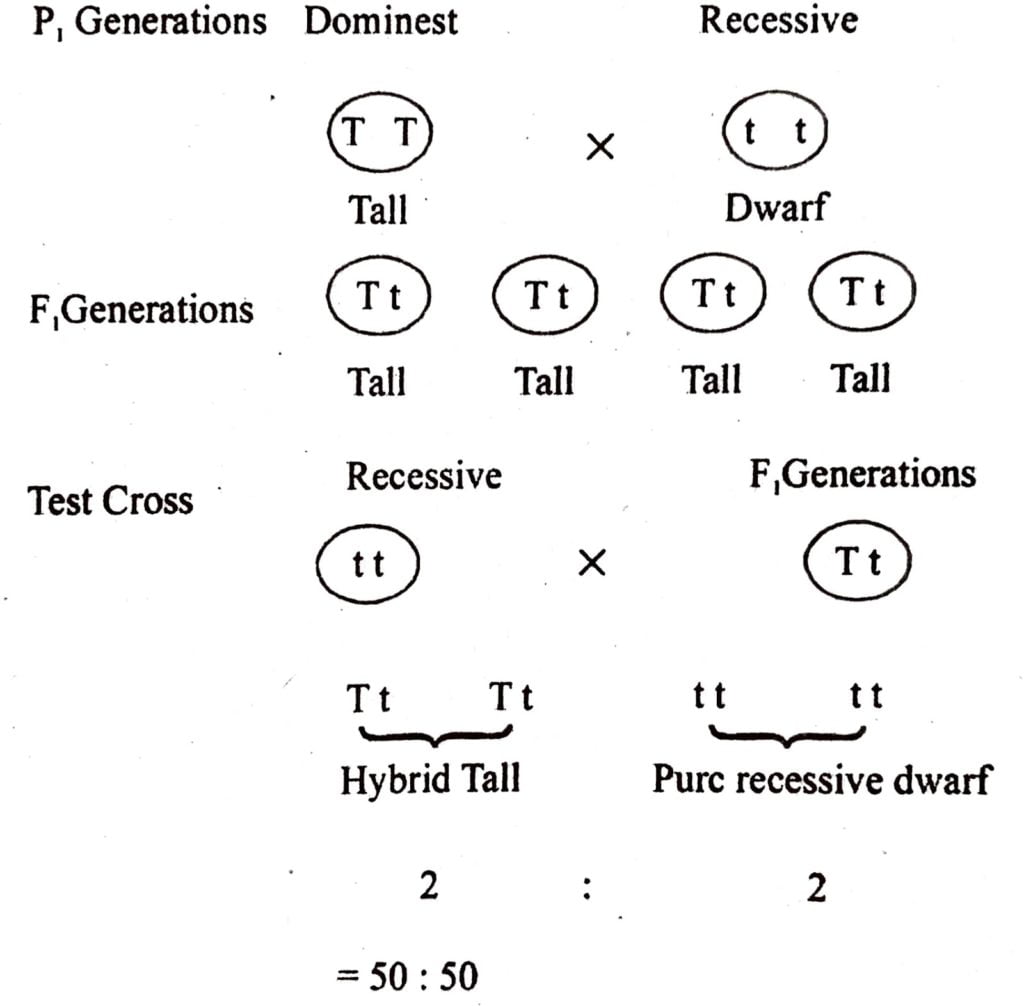Class 12 Biology Chapter 5 Principles of Inheritance and Variation The answer to each chapter is provided in the list so that you can easily browse through different chapters Assam Board HS 2nd Year Biology Chapter 5 Principles of Inheritance and Variation Question Answer.
Class 12 Biology Chapter 5 Principles of Inheritance and Variation
Also, you can read the SCERT book online in these sections Solutions by Expert Teachers as per SCERT (CBSE) Book guidelines. These solutions are part of SCERT All Subject Solutions. Here we have given Assam Board Class 12 Biology Chapter 5 Principles of Inheritance and Variation Solutions for All Subjects, You can practice these here.
Q.12. Write short notes on : (each carrying two marks)
(i) Sickle cell anaemia.
Ans : It is caused by an autosomal mutant allele Hbs, that in homozygous condition causes the production of an abnormal haemoglobin. Due to presence of abnormal haemoglobin the normal shape of RBCS is changed and they assume elongated, filamentous and sickle celled forms. Such RBCS show a short life span, since they clump together and often cause obstruction in the blood vessels. This causes severe anaemia. This disease sometime even causes death of the patient due to damaged heart, kidney, spleen and brain as a result of bloated blood vessels.
(ii) Pedigree analysis.
Ans : It is considered as the study of transfer and distribution of certain genetic traits through past generations of men and women. By pedigree analysis we can predict the chance of occurance of genetic diseases in their children even before a woman conceives.
(iii) Turner’s Syndrome.
Ans : The persons with 44 autosomes and one X-chromosome (44+X) suffer from Turner’s syndrome. They possess 45 chromosomes instead of normal chromosome number 46. The patient have feminine characters but with rudimentary gonads. They have short stature, shield chest and prominent webbing of the neck.
(iv) Down’s Syndrome.
Ans : The main symptoms are rounded face, broad fore-head, permanently open mouth, protruding tongue, projecting lower lip, short neck, broad palm with characteristic palmar crease and Mongolian type eye-lid fold.
(v) Haemophilia.
Ans : The human male never passes gene to his son for haemophilia because it is inherited through an X linked recessive gene. The haemophilic gene (Xʰ) is always associated with X-chromosome. Therefore daughter always receives Xʰ gene from father but not his son who receives Y- chromosome from father.

Q.13. What is point mutation? Give example.
Ans : The mutation that takes place in gene or DNA chain is called gene mutation or point mutation. Here as a result of gene mutation new alle;es of a gene are formed.
It is found genetically changed plants and animals.
Q.14. Define aneuploidy with example.
Ans : In aneuploids, the chromosome complement either has one or more chromosomes or one or more chromosomes less than the normal complement. The sematic chromosome number of an aneuploid differs from normal in the sense that it is not an exact multiple of basic haploid number. The number may be 2n+1, 2n+2, 2n-1, 2n-2 and so on.
Aneuploidy can be either due to less of one or more chromosomes (hypoploidy) or due to addition of one or more chromosomes to complete chromosomal complement (hyperploidy). Monosomy (2n-1), Nullisomy (2n-2), are the example of polyploidy while the trisomy (2n+1) and tetrasomy (2n+2) are the hyperploidy.
(E). Short Answer Question (3 Marks) :
Q.1. Elucidate Mendel’s law of segregation with the help of monohybrid cross.
Ans : Mendel selected garden pea for his experiment because it shows many contrasting characters. He selected seven pairs of contrasting characters in Pisum sativum.
Mendel first crossed pea plants differing in a single pair of contrasting character, such as tallness and dwarfness, smooth seeded and wrinkled seeded, yellow seeded and green seeded etc. He called the initial cross between two varieties as parental or P₁ generation. The offspring of the F₁ generation were found to bear, the character of one of the parents only and not of both in F₁ generation. The contrasting characters never mix up F₁ generation is the offspring of P₁ generation. When Mendel observed that in F₂ generation the contrasting characters were not evident he allowed the plants of F₁ generation to self-pollinate.
He collected all the seeds and sown them to produce F₂ generation. He noted with great interest that in F₂ generation the contrasting character came out in the proportion of 3:1. That was out of every 4 plants 3 plants showed the characters of one of the parent of P₁ generation grid and the other one showed the character of the other parent. He noted with interest that out of the 3 plants which showed dominant character did not breed true. Out of the 3 plants only one breed pure and the other-2 segregated in the ratio of 3 :1 again. But out of the 4 plants in F₂ generation the one which showed only recessive character did not segregate but breed true to its type.
Mendel called this as Monohybrid Ratio and the cross between the plants in which one pair of contrasting characters were taken was called Monohybrid cross.
In monohybrid cross in F₁ generation the offsprings are tall. Tallness is dominant and dwarfness is recessive. The dominant factor masked the recessive character. In F₂ generation the recessive character segregate out as pure dwarf. In a allelic pair always there will remain one dominant and one recessive trait. In F₁ generation, although the plants look tall, it is not pure tall. It has in it the recessive character (dwarfness) also. So it is only phenotypically tall but genotypically it carries the traits of both tallness and dwarfness (Tt).
Due to dominant factor, all plants of F₁ of their dominant parent. The recessive characters will however remain present in the somatic cells of the F₁ individuals throughout their whole life. But during the formation of gametes by reduction division each contrasting character segregates out and if such plant of F₁ generation are allowed to be self-pollinated then the resultant individuals will show character of either parent.
That is both the parental characters of P₁ generation will segregate out again in the F₂ generation. This is to say that if the characters of the parents remains suppressed in F₁ ; generation, it comes out in the F₂ generation. It means that the contrasting characters does not blend, contaminate or affect each other while they are together in the hybrid in the F₁ generation and segregare out in subsequent generation.

TT, Tt, Tt = 3 (Tall)
tt = 1 (dwarf)
∴ The ratio of Tall (TT/Tt) And dwarf (tt) is 3: 1.
Q.2. What does Mendel’s law of independent assortment state?
Ans : In F₁ generation only, the dominant character is visible. Recessive characters remain masked. But in F₂ generation, all the contrasting characters appear in different proportions. This shows that characters never blend. They remain pure and reappear at certain stage. This phenomenon is governed by the Mendel’s law of independent assortment. This also indicates that the gametes remain pure and reappear with distinct character.

Q.3. What is codominance?
Ans : Long years of study has shown that man inherits the blood group. There are three alleles which determine the blood group. A man may possess any one or two alleles which are located in one of the 22 autosomes. No person can possess antigen-A or antigen-B without hav their corresponding genes in autosomes. Similarly, if a person in his blood possesses antigen-A and antigen-B then he must carry the alleles corresponding to both the antigens. Here both the alleles-A and B are dominant and neither of them is suppressed by the other. Because of this unusual method of inheritance it has become customary to use the letter T(Isohemagglutinin) as symbol of the genes and with a second letter as an exponent to indicate which variation of the alleles is represented. For example Iᴬ represents the gene which produces antigen-A and Iᴮ is gene which produces antigen-B.
These alleles are found either in homozygous condition or heterozygous condition. Iᴬ in homozygous condition (Iᴬ Iᴬ) produces antigen-A, Iᴮ in homozygous condition (Iᴮ Iᴮ) produces antigen-B. But both alleles in heterozygous condition (Iᴬ Iᴮ) produces antigen-A and antigen-B (A and B being both dominant) I° is recessive to Iᴬ and Iᴮ. Therefore Iᴬ I° produces antigen-A and Iᴮ I° produces antigen-B. But I° in homozygous condition (I°I°) produces neither antigen-A nor antigen-B.
| Sl. No. | CONTENTS |
| Chapter 1 | Reproduction in Organisms |
| Chapter 2 | Sexual Reproduction in Flowering Plants |
| Chapter 3 | Human Reproduction |
| Chapter 4 | Reproductive Health |
| Chapter 5 | Principles of Inheritance and Variation |
| Chapter 6 | Molecular Basis of Inheritance |
| Chapter 7 | Evolution |
| Chapter 8 | Human Health and Disease |
| Chapter 9 | Strategies for Enhancement in Food Production |
| Chapter 10 | Microbes in Human Welfare |
| Chapter 11 | Biotechnology: Principles And Processes |
| Chapter 12 | Biotechnology and its Applications |
| Chapter 13 | Organisms and Populations |
| Chapter 14 | Ecosystem |
| Chapter 15 | Biodiversity and Conservation |
| Chapter 16 | Bioresources of Assam |
| Chapter 17 | Environmental Issues |
Q.4. Different between incomplete dominance and codominance.
Ans : Difference between incomplete dominance & codominance:
| Incomplete Dominance | Codominance | ||
| (i) | One of the two alleles shows more conspicuous effect. | (i) | Both the alleles shows equal effectiveness. |
| (ii) | Hybrid is the intermediate expression of two alleles. Iᴬ and I°, Hbˢ and Hbᴬ. | (ii) | Both the alleles shows their effect independently eg. |
| (iii) | Expression of hybrid is mixture of two alleles. | (iii) | No mixing takes place due to effect of two alleles. |
Q.5. Give the purpose and results of a test cross.
Ans : Test cross is a cross between phenotypically dominant F₁ hybrid with recessive parent to test the former whether it is homozygous or heterozygous. For example in F₁ generation there may be two types of tall plants such as TT and Tt. Both are tall. The former is homozygous and the later is heterozygous. To know which one is homozygous a test cross is conducted between all the tall plants and the recessive parent (tt). In cross between tall plants and the dwarf parent it will be observed that in certain cases the dominant amd the recessive character will appear in 50: 50 ratio. The F₁ heterozygous tall (Tt) plants can be identified on the basis of the result of the test cross result that produce hybrid tall plants and dwarf plants in the ratio of 50: 50.

Q.6. What are the various causes of human genetic disorders?
Ans : (i) Mendelian Disorder : Mendelian disorder occur due to alteration or mutation of single gene. Such disorder is associated with defect of enzyme action as because each gene control one enzyme. Such disease is inherited in Mendelian fashion.
Phenylketonuria, alkaptonuria are such diseases.
(ii) Chromosomal Disorder : Various genetic diseases are known which are caused by abnormality of the autosomal chromoscme (not connected with determination of sex). Autosomal abnormality may be due to polyploidy (more than normal diploid set of chromosome) or may be due to aneuploidy (one chromosome may be more or less than the normal). Aneuploidy has several forms. Sometime 21st pair or 18th pair or 13th pair of chromosomes fail to separate during meiosis. Fertilization between one normal gamete and one abnormal gamete with non- disjunctioned chromosome gives rise to individual having one extra chromosome such as 3 sets of 21st or 18th or 13th Chromosome.
This phenomenon is called trisomy. Similarly one chromosome of 21st pair or 18th pair may deleted. In such condition the diploid cell will contain one chromosome less. This phenomenon is called monosomy. In trisomic condition the body cells contain 47 chromosomes (one chromosome more) but in monosomic condition the body cells contain 45 chromosomes (one chromosome less).
Q.7. Explain the concept of dominance.
Ans : Of the two contrasting hereditary unit characters, the one that expresses itself in the F₁ generation is called dominant and the other which remains latent is called recessive. For example, if tall and dwarf plants are crossed then ‘fallness’ being the dominant character over the “dwartness’ all plants in the F₁ generation will be tall. But dwarfness which remains latent in F₁ generation will express itself in F₁ generation. Similarly, round seeded plant is dominant over wrinkled seeded plants, yellow seeded plants is dominant over the green suede plants.
It was found later that dominance is absent in many cases In such cases, the hybrid does not resemble either of the presents exactly. Sometimes, they resemble in between the two. For example, when while snapdragon plant is crossed with red snapdragon plant, the hybrid is pink flowered. So, the dominance is incomplete . In such case the term incomplete dominance is applied.

Hi, I’m Dev Kirtonia, Founder & CEO of Dev Library. A website that provides all SCERT, NCERT 3 to 12, and BA, B.com, B.Sc, and Computer Science with Post Graduate Notes & Suggestions, Novel, eBooks, Biography, Quotes, Study Materials, and more.


